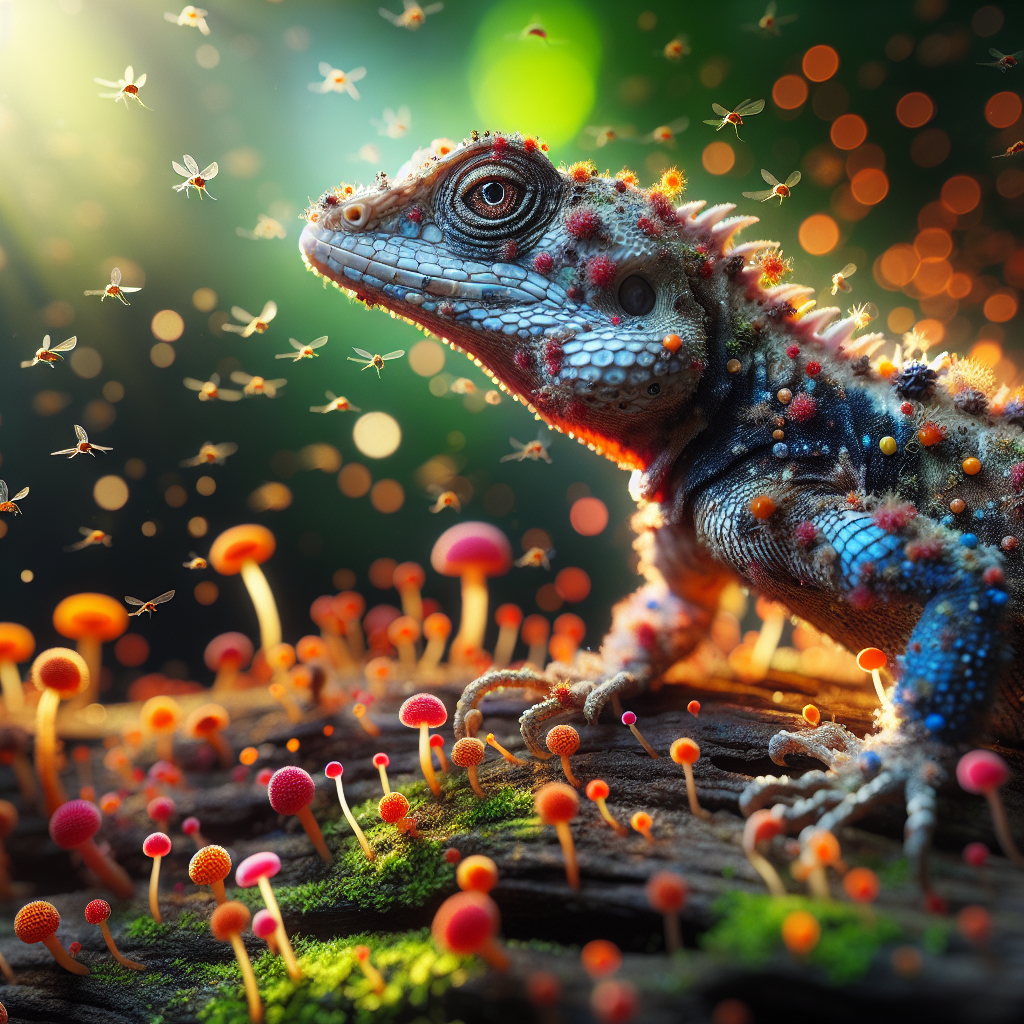Introduction: Understanding Fungal Infections in Lizards
Fungal infections in lizards may seem like a niche topic, but trust me, it’s a crucial one. Picture this – you’re all excited about your new pet lizard, setting up its vivarium with care and joy. But then, out of nowhere, your little reptilian friend starts showing signs of discomfort. It’s heartbreaking. And that’s where understanding fungal infections becomes a game-changer.
Now, here’s a little fun fact for you – did you know that lizards are particularly susceptible to fungal infections due to their unique skin structure? Yep, their scales provide the perfect breeding ground for those pesky fungi to thrive. But fear not, because knowledge is power when it comes to keeping your scaly buddy healthy and happy.
So, let’s dive into the nitty-gritty of fungal infections in lizards. From the common causes to the telltale symptoms, we’ll cover it all. And when it comes to treatment options, I’ll let you in on some insider tips to help your lizard bounce back to its vibrant self.
But prevention is key, my friend. I’ll share some practical advice on how to create a safe and hygienic environment for your lizard to prevent fungal infections from taking hold. Remember, a little proactive care goes a long way in ensuring your lizard’s well-being.
So, buckle up and get ready to become a lizard health guru. Together, we’ll navigate the fascinating world of fungal infections in lizards and ensure that your scaly companion lives its best life.
Causes of Fungal Infections in Lizards
Have you ever wondered what causes fungal infections in lizards? Well, let’s dive in. Fungal infections in lizards are often triggered by environmental factors. Humidity levels play a crucial role. Did you know that high humidity can create the perfect breeding ground for fungal spores? It’s like a cozy spa retreat for those pesky fungi. As a lizard owner, you need to keep a close eye on your pet’s living conditions. Ensure their habitat is well-ventilated and not overly damp. Prevention is key when it comes to fungal infections. By maintaining optimal humidity levels, you can significantly reduce the risk. Now, imagine your lizard basking in the sun, carefree and healthy, without a worry in the world. Treat your scaly friend to a spa day of their own – minus the fungi! Remember, a little preventive care goes a long way in keeping your lizard happy and thriving. So, are you ready to take on the challenge of creating the perfect lizard paradise? Let’s ensure those fungi stay far, far away from our reptilian companions.
Symptoms of Fungal Infections in Lizards
As we delve into the symptoms of fungal infections in lizards, it’s crucial to stay vigilant. One telltale sign to watch out for is changes in your lizard’s skin. Have you ever noticed any unusual discoloration or texture on your scaly friend’s skin? These could be early indicators of a fungal infection creeping in. Another symptom to keep an eye on is shedding irregularities. If your lizard’s shedding pattern seems off or if it’s struggling to shed properly, it might be a red flag for a fungal infection lurking beneath the surface. Additionally, pay close attention to any signs of lethargy or decreased appetite in your lizard. Just like us, when lizards aren’t feeling their best, they may show a lack of energy or interest in food. If you notice these symptoms persisting, it’s time to take action and seek proper veterinary care. Remember, early detection is key to effectively treating fungal infections in lizards and ensuring your scaly companion stays healthy and happy. By being proactive and observant, you can nip potential issues in the bud before they escalate. Your lizard will thank you for it with its vibrant colors and playful antics.
Diagnosing Fungal Infections in Lizards
When it comes to diagnosing fungal infections in lizards, it’s all about paying attention to detail. These little creatures may not always show obvious symptoms, so you’ve got to be a detective of sorts. Picture this: you’re observing your lizard and notice some subtle changes in its behavior. Maybe it’s not as active as usual or seems a bit off its game. These could be early signs of a fungal infection brewing. Keep a close eye on its skin and scales. Any discoloration, flakiness, or unusual texture could indicate trouble. Remember, prevention is key. Ensure your lizard’s habitat is clean and well-maintained to minimize the risk of fungal infections. Pro tip: regular check-ups with a reptile veterinarian can help catch issues early on. Stay curious and observant – your lizard’s health depends on it. Now, imagine yourself as a lizard detective, cracking the case of fungal infections before they take hold. It’s a fascinating journey into the hidden world of lizard health, where every clue matters. Get ready to dive deep into the realm of lizard care and become a fungal infection expert in your own right.
Treatment Options for Fungal Infections in Lizards
Fungal infections in lizards can be a tricky business, but let me break it down for you. Picture this: your beloved lizard starts acting a bit off, maybe less energetic than usual. It’s a concerning sight, right? Well, these could be early signs of a fungal infection creeping in.
Now, here’s a fascinating tidbit for you: did you know that fungal infections in lizards can often be linked to environmental factors? Yep, sometimes it’s all about the conditions in their habitat that pave the way for these pesky infections to take hold.
So, what’s the deal with treating fungal infections in lizards? It’s not as simple as popping a pill like we humans do. Lizards have unique biology, and treating them requires a delicate touch. It’s like solving a puzzle, figuring out the best approach to help your scaly friend bounce back to health.
But here’s the kicker: prevention is key! Taking proactive steps to create a clean and optimal living environment for your lizard can go a long way in warding off fungal infections. It’s like building a fortress of wellness around your pet, keeping those nasty fungi at bay.
Now, let me pose a question to you: have you ever encountered a fungal infection in your lizard? How did you handle it? Share your experiences in the comments below – let’s learn from each other and keep our scaly companions happy and healthy!
Preventing Fungal Infections in Lizards
Have you ever wondered how to keep your lizard safe from those pesky fungal infections? Let me tell you, prevention is key when it comes to your scaly friend’s health. Picture this: a cozy terrarium, plenty of fresh air, and proper hygiene practices. It may sound simple, but these steps can work wonders in keeping those fungi at bay. Now, imagine this: a little lizard, basking in the warmth of its habitat, completely unaware of the potential lurking dangers. As lizard owners, it’s our duty to stay vigilant and protect our beloved pets from harm. That’s why understanding the common types of fungal infections that can affect lizards is crucial. Did you know that certain species of lizards are more prone to fungal infections than others? It’s a fascinating fact that sheds light on the importance of tailored care for different lizard breeds. So, here’s a thought-provoking question for you: How can we strike a balance between ensuring our lizards thrive in their environment while safeguarding them against fungal threats? Let’s delve deeper into this topic and explore the intricate world of fungal infections in lizards together.
Common Types of Fungal Infections in Lizards
When it comes to common types of fungal infections in lizards, there’s one that stands out – the dreaded “Yellow Scale Disease.” This fungal infection, also known as Ophidiomycosis, primarily affects snakes but can also impact lizards. Picture this: you’re admiring your beautiful lizard, and suddenly you notice patches of yellow scales appearing on its skin. It’s like a scene from a sci-fi movie, but unfortunately, it’s a real threat to your scaly friend.
Yellow Scale Disease is caused by the fungus Ophidiomyces ophiodiicola, which thrives in warm and humid environments. It can lead to skin lesions, crusty scales, and overall discomfort for your lizard. Moreover, this infection can be challenging to diagnose and treat effectively, making prevention crucial.
To protect your lizard from Yellow Scale Disease and other fungal infections, maintaining proper hygiene and habitat conditions is key. Ensure your lizard’s enclosure is clean, dry, and well-ventilated to reduce the risk of fungal growth. Additionally, regularly inspect your lizard for any unusual skin changes or behaviors that could indicate a fungal infection.
Remember, prevention is always better than cure when it comes to fungal infections in lizards. By staying vigilant and providing a healthy environment for your scaly companion, you can help them thrive and stay fungus-free. So, keep an eye out for those yellow scales and take action to keep your lizard happy and healthy!
Impact of Fungal Infections on Lizard Health
Fungal infections in lizards can have a significant impact on their overall health and well-being. Picture this: your beloved lizard starts to exhibit strange behaviors, like lethargy or loss of appetite. You might think it’s just a passing phase, but it could be a sign of a fungal infection brewing beneath the surface.
Here’s where things get interesting. Did you know that fungal infections in lizards can sometimes go unnoticed until they reach an advanced stage? These infections can be sneaky, manifesting in subtle ways that are easy to miss if you’re not paying close attention.
Now, imagine this scenario: you finally realize that your lizard is battling a fungal infection. What do you do next? This is where things can get tricky. Treating fungal infections in lizards requires a delicate balance of medication, environmental adjustments, and expert care.
So, how can you ensure your lizard receives the best possible treatment for a fungal infection? It’s crucial to consult a reptile veterinarian with experience in treating such conditions. They can provide personalized guidance and support to help your lizard recover and thrive.
Remember, early detection and prompt intervention are key when it comes to managing fungal infections in lizards. By staying vigilant and proactive, you can safeguard your scaly friend’s health and happiness for years to come.
When to Seek Veterinary Care for Fungal Infections in Lizards
When it comes to fungal infections in lizards, knowing when to seek veterinary care is crucial. Sometimes, it can be tricky to determine if your scaly friend needs professional help or if home remedies will do the trick. Remember, your lizard’s health should always come first. If you notice persistent symptoms like skin discoloration, unusual behavior, or appetite loss, don’t hesitate to consult a reptile specialist. Ignoring these signs could worsen the infection and harm your lizard’s well-being. It’s like when you have a nagging feeling that something’s not right but keep brushing it off until it becomes a bigger issue. Prevention is key, but timely intervention is equally important. Think of your lizard as a family member – you wouldn’t ignore their health concerns, right? So, be proactive and seek professional advice when in doubt. Your lizard will thank you for it, even if they can’t express it in words. After all, a healthy lizard is a happy lizard!
Conclusion: Maintaining Lizard Health and Wellness
As one of the leading experts in the field of fungal infections in lizards, let me tell you, these little reptiles can be quite sensitive creatures. Picture this: you’re setting up a cozy habitat for your lizard, all excited to bring home your new scaly friend. But wait, did you know that fungal infections can sneak up on them unexpectedly? It’s like a lurking shadow in the world of lizard care. The thing about fungal infections in lizards is that they often go unnoticed until it’s too late. That’s why being proactive and informed is key to keeping your scaly buddy healthy and happy.
Now, let’s dive into the nitty-gritty details. Fungal infections in lizards can be caused by various factors, from poor hygiene to stress. Just like us, lizards can get stressed out too! Imagine feeling under the weather and not being able to communicate it. It’s a challenging situation, right? So, it’s crucial to keep an eye out for any signs of discomfort or unusual behavior in your lizard. Think of it as being a detective in the world of lizard health.
But fret not! There are ways to prevent and treat fungal infections in lizards. From creating a clean and cozy habitat to providing a balanced diet, there are simple steps you can take to protect your scaly companion. So, the next time you notice something off with your lizard, remember, a little extra care goes a long way in keeping them healthy and thriving.




